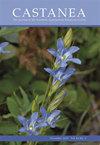Life After Privet: Plant Community Dynamics in a Forested Wetland Following Removal of the Invasive Ligustrum sinense Lour
IF 0.3
4区 生物学
Q4 PLANT SCIENCES
引用次数: 0
Abstract
ABSTRACT Chinese privet (Ligustrum sinense) invasion has been found to reduce native species richness and abundance of both herbaceous and woody plants and is a serious threat to wetlands in the southeastern United States. To determine the relationship between privet removal and understory vegetation, we performed surveys on a forested wetland from which L. sinense had been partially removed over a two-year period. Plant community composition, vegetation cover and species richness as well as soil moisture and PAR were recorded in removal and control (Privet-Present) plots in herb, shrub and tree layers. As expected, herb-layer removal plots were wetter and less shady, with more than four times higher cover of native and non-native species. Total species richness and native species richness were both higher in herb-layer removal plots, though non-native species richness did not differ. Shrub-layer removal plots were much less dense, with 1/100 the basal area of shrubs than control plots. Tree-layer plots did not differ in any measure, suggesting that control and removal plot types were historically similar and continued to support comparable overstory vegetation. The composition of woody seedlings in the herb layer did not reflect the mature overstory in either plot type, although several of the most abundant woody seedlings were those of dominant wetland species. We conclude that immediately following L. sinense removal, native species outperform non-natives, both in cover and species richness in the herb layer. The poor recruitment of woody seedlings and saplings as well as the rapid invasion of invasive Japanese stiltgrass (Microstegium vimineum) may thwart restoration efforts, however. To ensure the wetland reaches its pre-invasion community structure, it may be necessary to plant native tree saplings and nurture them through the shrub layer to maturity.女贞树后的生活:移除入侵女贞后森林湿地的植物群落动态
摘要中国女贞(Ligustrum sinense)的入侵已被发现会降低当地草本和木本植物的物种丰富度和丰度,并对美国东南部的湿地构成严重威胁。为了确定女贞的移除与林下植被之间的关系,我们对一片森林湿地进行了调查,在两年的时间里,该湿地已被部分移除。在草本、灌木和乔木层的移除和控制(Privet-Present)地块中记录了植物群落组成、植被覆盖和物种丰富度以及土壤湿度和标准杆数。正如预期的那样,草本植物层清除地更潮湿,阴凉更少,本地和非本地物种的覆盖率高出四倍多。草本层去除地的总物种丰富度和本地物种丰富度均较高,但非本地物种丰富度没有差异。灌木层移除地块的密度要低得多,灌木的基底面积是对照地块的1/100。乔木层地块在任何方面都没有差异,这表明控制和移除地块类型在历史上是相似的,并继续支持可比较的过度生长植被。草本层中木本幼苗的组成并不能反映出两种地块类型中成熟的过度贮藏,尽管一些最丰富的木本幼苗是优势湿地物种的木本幼苗。我们得出的结论是,在去除L.sinense后,本地物种在草本层的覆盖率和物种丰富度方面都优于非本地物种。然而,木质幼苗和树苗的缺乏以及入侵的日本吊脚草(Microstegium vimineum)的快速入侵可能会阻碍恢复工作。为了确保湿地达到入侵前的群落结构,可能有必要种植原生树苗,并通过灌木层培育至成熟。
本文章由计算机程序翻译,如有差异,请以英文原文为准。
求助全文
约1分钟内获得全文
求助全文
来源期刊

Castanea
生物-植物科学
CiteScore
0.50
自引率
25.00%
发文量
28
审稿时长
>12 weeks
期刊介绍:
Castanea is named in honor of the American Chestnut tree. Castanea is thebotanical name for Chestnuts, dating back to what the ancient Greeks calledthem.
The American Chestnut is a critically endangered tree that once made up 35%of the forests of the Eastern US before being devastated by a blight thatdestroyed up to 4 billion American Chestnut trees.
Castanea serves professional and amateur botanists by reviewing andpublishing scientific papers related to botany in the Eastern United States.
We accept papers relating to plant biology, biochemistry, ecology, floristics,physiology and systematics.
 求助内容:
求助内容: 应助结果提醒方式:
应助结果提醒方式:


